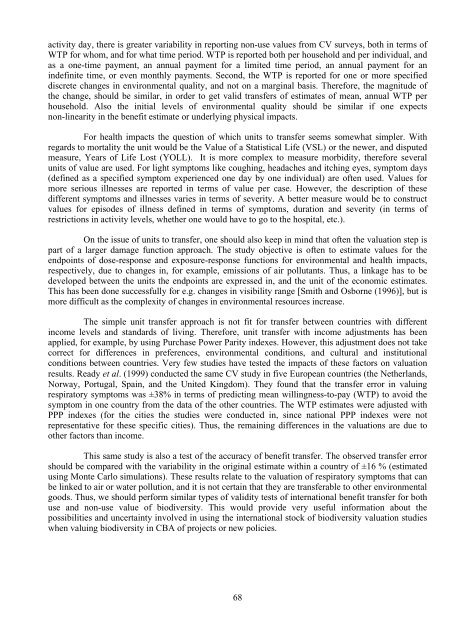Valuation of Biodiversity Benefits (OECD)
Valuation of Biodiversity Benefits (OECD)
Valuation of Biodiversity Benefits (OECD)
- No tags were found...
Create successful ePaper yourself
Turn your PDF publications into a flip-book with our unique Google optimized e-Paper software.
activity day, there is greater variability in reporting non-use values from CV surveys, both in terms <strong>of</strong>WTP for whom, and for what time period. WTP is reported both per household and per individual, andas a one-time payment, an annual payment for a limited time period, an annual payment for anindefinite time, or even monthly payments. Second, the WTP is reported for one or more specifieddiscrete changes in environmental quality, and not on a marginal basis. Therefore, the magnitude <strong>of</strong>the change, should be similar, in order to get valid transfers <strong>of</strong> estimates <strong>of</strong> mean, annual WTP perhousehold. Also the initial levels <strong>of</strong> environmental quality should be similar if one expectsnon-linearity in the benefit estimate or underlying physical impacts.For health impacts the question <strong>of</strong> which units to transfer seems somewhat simpler. Withregards to mortality the unit would be the Value <strong>of</strong> a Statistical Life (VSL) or the newer, and disputedmeasure, Years <strong>of</strong> Life Lost (YOLL). It is more complex to measure morbidity, therefore severalunits <strong>of</strong> value are used. For light symptoms like coughing, headaches and itching eyes, symptom days(defined as a specified symptom experienced one day by one individual) are <strong>of</strong>ten used. Values formore serious illnesses are reported in terms <strong>of</strong> value per case. However, the description <strong>of</strong> thesedifferent symptoms and illnesses varies in terms <strong>of</strong> severity. A better measure would be to constructvalues for episodes <strong>of</strong> illness defined in terms <strong>of</strong> symptoms, duration and severity (in terms <strong>of</strong>restrictions in activity levels, whether one would have to go to the hospital, etc.).On the issue <strong>of</strong> units to transfer, one should also keep in mind that <strong>of</strong>ten the valuation step ispart <strong>of</strong> a larger damage function approach. The study objective is <strong>of</strong>ten to estimate values for theendpoints <strong>of</strong> dose-response and exposure-response functions for environmental and health impacts,respectively, due to changes in, for example, emissions <strong>of</strong> air pollutants. Thus, a linkage has to bedeveloped between the units the endpoints are expressed in, and the unit <strong>of</strong> the economic estimates.This has been done successfully for e.g. changes in visibility range [Smith and Osborne (1996)], but ismore difficult as the complexity <strong>of</strong> changes in environmental resources increase.The simple unit transfer approach is not fit for transfer between countries with differentincome levels and standards <strong>of</strong> living. Therefore, unit transfer with income adjustments has beenapplied, for example, by using Purchase Power Parity indexes. However, this adjustment does not takecorrect for differences in preferences, environmental conditions, and cultural and institutionalconditions between countries. Very few studies have tested the impacts <strong>of</strong> these factors on valuationresults. Ready et al. (1999) conducted the same CV study in five European countries (the Netherlands,Norway, Portugal, Spain, and the United Kingdom). They found that the transfer error in valuingrespiratory symptoms was ±38% in terms <strong>of</strong> predicting mean willingness-to-pay (WTP) to avoid thesymptom in one country from the data <strong>of</strong> the other countries. The WTP estimates were adjusted withPPP indexes (for the cities the studies were conducted in, since national PPP indexes were notrepresentative for these specific cities). Thus, the remaining differences in the valuations are due toother factors than income.This same study is also a test <strong>of</strong> the accuracy <strong>of</strong> benefit transfer. The observed transfer errorshould be compared with the variability in the original estimate within a country <strong>of</strong> ±16 % (estimatedusing Monte Carlo simulations). These results relate to the valuation <strong>of</strong> respiratory symptoms that canbe linked to air or water pollution, and it is not certain that they are transferable to other environmentalgoods. Thus, we should perform similar types <strong>of</strong> validity tests <strong>of</strong> international benefit transfer for bothuse and non-use value <strong>of</strong> biodiversity. This would provide very useful information about thepossibilities and uncertainty involved in using the international stock <strong>of</strong> biodiversity valuation studieswhen valuing biodiversity in CBA <strong>of</strong> projects or new policies.68












